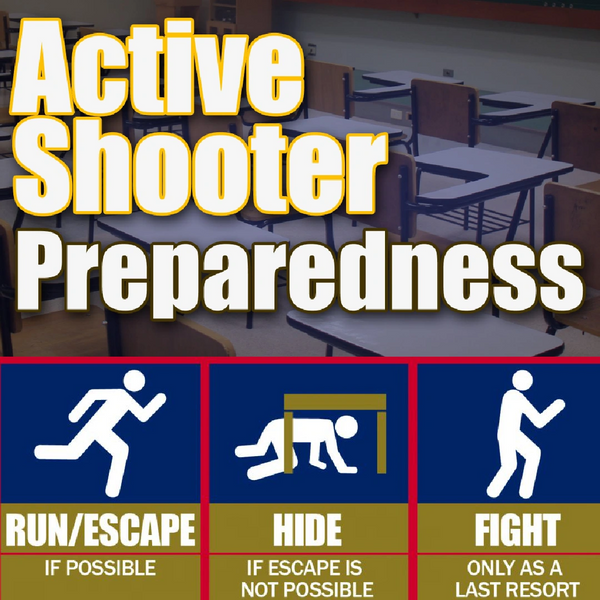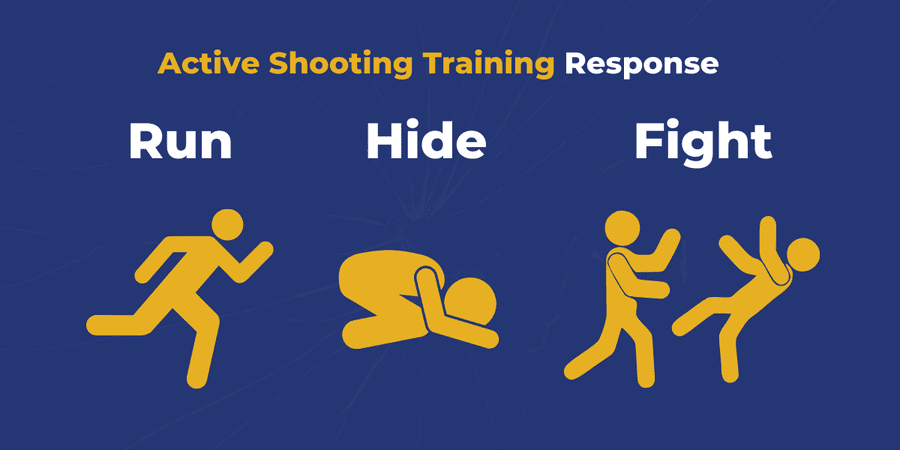The Benefits of Ongoing Active Shooter Training for Area Security
The Benefits of Ongoing Active Shooter Training for Area Security
Blog Article
Discovering the Key Components and Goals of Efficient Energetic Shooter Training Programs
Energetic shooter training programs are critical in gearing up individuals and organizations with the needed abilities to react successfully to possible hazards. These programs incorporate essential components, such as the "Run, Hide, Fight" strategy, realistic scenario simulations, and communication protocols, cultivating a setting of readiness. They emphasize emotional strength to assist participants navigate high-stress scenarios. As we discover the ins and outs of these training programs, it ends up being apparent that understanding their comprehensive nature is essential to boosting precaution and response capacities. What certain aspects truly specify their efficiency?
Relevance of Active Shooter Training
Energetic shooter training programs are essential for boosting preparedness and action in the face of prospective hazards. These programs aim to furnish individuals, organizations, and neighborhoods with the expertise and skills needed to effectively reply to energetic shooter situations. The enhancing regularity and severity of such events emphasize the importance of positive actions, as prompt and informed reactions can dramatically mitigate harm.
Furthermore, energetic shooter training cultivates a society of safety and awareness within organizations, whether they be institutions, offices, or public places. Individuals learn to recognize early indication and comprehend the value of interaction and team effort throughout emergency situations. This training not just highlights private security however likewise advertises a collective obligation to safeguard others.
Furthermore, these programs can assist minimize the stress and anxiety and anxiety that typically accompany discussions regarding prospective risks. By providing organized support and useful strategies, individuals gain self-confidence in their capacity to respond properly. Eventually, the value of active shooter training lies in its possible to conserve lives, decrease injuries, and cultivate a ready and durable community qualified of encountering unanticipated difficulties.
Key Elements of Training Programs
Efficient active shooter training programs typically include a number of key parts developed to prepare individuals for real-world situations. The first part is extensive education and learning on the nature of active shooter incidents, consisting of statistics, instance studies, and emotional elements that affect aggressors. This academic structure is important for fostering understanding and understanding amongst participants.
Following, programs frequently consist of training on individual security actions, highlighting the "Run, Hide, Battle" strategy. Participants find out how to examine their setting, make quick decisions, and take ideal actions during a situation. Additionally, the addition of reliable interaction skills is important, as individuals have to understand exactly how to report occurrences and share essential details with police.
One more necessary part is the involvement of police or safety specialists, that provide insights into tactical reactions and the value of teamwork throughout a dilemma. Programs need to resolve the emotional results of an energetic shooter scenario, using methods for coping and recovery.
Lastly, ongoing training and refresher course training courses are essential to make certain that expertise stays current and participants feel great in their capabilities. Together, these vital parts produce an all-round training program that gears up individuals to react efficiently to an active shooter occasion.
Realistic Situation Simulations
Reasonable circumstance simulations are a vital facet of active shooter training programs, supplying individuals with the chance to take part in hands-on practice that mirrors prospective real-life scenarios. These simulations enhance the training experience by producing an immersive setting where individuals can apply academic expertise in practical settings.
With using role-playing, mock situations, and specialized training centers, individuals experience the prompt challenges and stressors linked with an energetic shooter incident. This method of training promotes quick decision-making, synergy, and the application of safety and security protocols under pressure. It allows responders to establish essential abilities such as situational awareness, risk evaluation, and efficient evacuation procedures.
Additionally, sensible simulations aid to recognize possible weak points in individuals' feedbacks, making it possible for instructors to give targeted responses and boost total readiness. The consolidation of differing situations, including different locations and aggressor accounts, better improves the training experience, making sure that individuals are fully equipped to deal with a range of potential scenarios.
Inevitably, these simulations serve not only to advise yet likewise to build self-confidence amongst participants, fostering a feeling of preparedness i was reading this that is vital for effective emergency situation action when faced with an active shooter hazard.
Communication Strategies in Training
Clear interaction is crucial in active shooter training programs, as it straight influences the performance of feedback efforts during a dilemma. active shooter training. Training participants have to comprehend the protocols and treatments that will assist their actions if confronted with an active shooter scenario. Developing clear lines of communication makes sure that all individuals included can relay info promptly and precisely

In addition, training programs must stress the significance of energetic listening. Participants need to be educated to interpret and reply to info effectively, lessening misconceptions that could cause dangerous scenarios. Regular comments sessions post-training can additionally improve communication techniques, making sure that all individuals feel empowered to share their experiences and tips for improvement. Ultimately, efficient interaction approaches are essential for preparing individuals to respond decisively and cohesively when faced with an energetic shooter case.

Mental Readiness Strategies
Psychological preparedness methods are significantly identified as important elements of energetic shooter training programs - active shooter training. These strategies intend to equip individuals with the mental resilience required to respond successfully in high-stress circumstances. By cultivating a frame of mind attuned to potential risks, participants can better manage worry, anxiety, and confusion during crucial events
Key psychological preparedness strategies include scenario-based training and stress vaccination workouts. Scenario-based training submerses individuals in reasonable simulations that imitate the mayhem of an active shooter occasion, permitting them to practice decision-making under pressure. This exposure aids develop experience with emergency protocols, boosting second-nature reactions.
Tension inoculation involves gradual exposure to stress-inducing situations, enabling individuals to develop coping mechanisms. This can include breathing exercises, visualization strategies, and cognitive restructuring to reframe unfavorable thoughts. By integrating these strategies, training programs can cultivate a feeling of confidence and control, which is vital in dilemma circumstances.
Furthermore, post-incident emotional support is important to address the psychological results of an active shooter event. Integrating mental health sources right into important link training programs not only prepares people for prompt reactions yet additionally promotes long-lasting emotional wellness, ultimately adding to a safer and a lot more resistant environment.
Final Thought
In verdict, efficient energetic shooter training programs are important for improving readiness and reaction abilities despite potential dangers. By including crucial elements such as realistic scenario simulations, communication approaches, and emotional preparedness techniques, these programs furnish people and companies with the necessary skills to navigate high-stress circumstances. Eventually, a thorough approach to training fosters resilience and promotes a culture of security, consequently adding this page to the general protection of communities in case of an active shooter incident.
Report this page